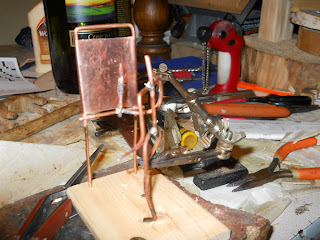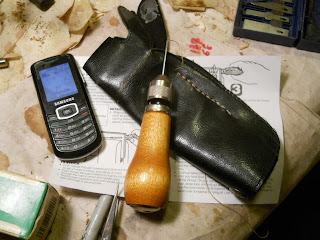Nice thing about walking: I can take pictures. Camera must be kept warm at all costs, or the batteries default on their duty. And I have both hands free. I can fish the camera out of the clothing and take a picture before my hands freeze to death. I have to remove super-mittens, though. No sacrifice too great for the blog.
So here is a winter walk in the Alaska bush. It is about 10AM -- just after sunrise in January. We walk down Basargin Drive. The first thing we see is...
 ... a couple of birch trees, young'uns bent double by the snow load. If it were spring we could make a greenhouse of of them! Alas, it is January. Maybe 70 cm of snow on the ground. Major project getting to these babies!
... a couple of birch trees, young'uns bent double by the snow load. If it were spring we could make a greenhouse of of them! Alas, it is January. Maybe 70 cm of snow on the ground. Major project getting to these babies!So on we go. We stop to look at what Little Lonely Lake is doing.
 It looks rather blue. Maybe it's too cold! No, it is a camera problem. Too much contrast for proper color recording. It is really white, but it's in the shade. Very few snow machine tracks. What a pity (cynical smile). So on we go.
It looks rather blue. Maybe it's too cold! No, it is a camera problem. Too much contrast for proper color recording. It is really white, but it's in the shade. Very few snow machine tracks. What a pity (cynical smile). So on we go. The rising sun is lighting up the roadside trees. Deep shadow elsewhere. Stunning, I think. After a while we reach one of the houses alogn Beryozova road. The name of the road is Russian (natch. It leads to the Russian village). It means "of the birches" road, very apt. So we come to non-village, but sometimes inhabited territory.
The rising sun is lighting up the roadside trees. Deep shadow elsewhere. Stunning, I think. After a while we reach one of the houses alogn Beryozova road. The name of the road is Russian (natch. It leads to the Russian village). It means "of the birches" road, very apt. So we come to non-village, but sometimes inhabited territory. Lot of snow on the roof! The residents are not in residence. Perhaps they are snowbirds. But mysteriously their driveway gets plowed, no doubt by divine providence. Wish my driveway got done that way. Well, we turn back eventually and get home. We are glad to see our driveway.
Lot of snow on the roof! The residents are not in residence. Perhaps they are snowbirds. But mysteriously their driveway gets plowed, no doubt by divine providence. Wish my driveway got done that way. Well, we turn back eventually and get home. We are glad to see our driveway. We note that it is plowed (actually snow-blowered), but regret that Divine providence did not favor us. Sigh. Do it yourself, again. Note that the sun is just now clearing the trees. It must be 1100 hours. Nice thing is that the days are getting longer.
We note that it is plowed (actually snow-blowered), but regret that Divine providence did not favor us. Sigh. Do it yourself, again. Note that the sun is just now clearing the trees. It must be 1100 hours. Nice thing is that the days are getting longer.And so, home. Have a cup of tea, enjoy the warmth (if, that is, you remembered to start a fire that morning) and on with the rest of the day.













